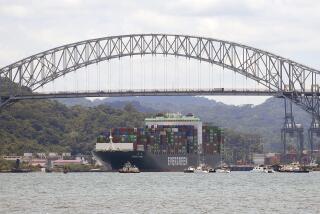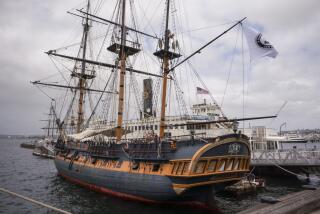Victoria is latest queen in Cunardâs lineage
Reporting from The Queen Victoria â The rising sun peeked under red-orange clouds splayed over the Caribbean port of CristĂłbal and backlighted the small armada of ships anchored there, waiting their turn at the Panama Canal. Cups of cappuccino in hand, my wife, Laurel, and I stepped out on the veranda of our cabin aboard Cunard Lineâs Queen Victoria, two weeks into its 2009 world cruise from Southampton, England.
FOR THE RECORD:
Queen Victoria: A Jan. 24 article about crossing the Panama Canal on the cruise ship Queen Victoria identified a ship in the Port of Los Angeles as the Jeremiah OâBrien. The ship is the Lane Victory, which served in World War II and the Korean and Vietnam wars. â
The still, bright morning last January was already warming to the heat typical of Panama, and we were primed with interest in the canal.
Truth to tell, Laurel is less in love with canals and their attendant locks and tugs and machinery than I.
Queen Victoriaâs current world cruise ends in April. The next cruise begins Jan. 5. Info: (800) 728-6273, www.cunard.com.
From September through April, most cruise lines offers Panama Canal trips, either full transits or partial transits, the latter turning in Gatun Lake and leaving the way they entered.
âItâs a lot like watching grass grow,â sheâd said in advance. She was skeptical even though Iâd extolled the process: chambers filling and emptying, lock gates closing and opening majestically like the jaws of Monstro the Whale, little electrified âmulesâ -- locomotives -- scurrying into place with cables to hold the vessels off the lock walls.
But by the time weâd reached CristĂłbal, it was she who had completed David McCulloughâs hefty but fascinating âThe Path Between the Seasâ and thus was able to fill me in about one of the man-made wonders of the world.
When we arrived at the canal weâd been aboard the Queen Victoria a full week. We werenât just marking time, waiting for the main event; we were traveling for the ship as much as the canal. A year earlier, we had sailed from Southampton to New York on the Victoria. We liked the ship enough to book this New York- Los Angeles segment while we were still aboard.
Comparisons may be invidious, but theyâre inevitable. For the Queen Victoria, the inescapable benchmark is fleet mate Queen Mary 2, and the ships are sometimes confused. Though the Queen Victoria does echo many interior features of the QM2, which was the largest ship ever built when it set out on its maiden voyage in January 2004, the Victoria is essentially a cruise ship, not an âexpress linerâ like QM2, which is built for point-to-point voyages in any weather.
Cunard ships are genuinely distinctive.
âMidnight finds you having the most intimate of moments in the grandest of ballrooms,â reads one of Cunardâs typical print ads, with a picture of tuxedo- and gown-clad passengers dancing decorously. Well, not exactly. Midnight generally finds us sound asleep, even on shipboard. Still, acknowledging the inevitable promotional hype, the adâs promise that a Cunard voyage âwill take you back to the Golden Age of Ocean Travel, when timeless elegance and refined British tradition ruled the dayâ is a fair summary of how the company sees its niche.
Our 17-night cruise included four formal nights. Though the tux-and-gown thing is surely not for everyone, we like it.
The âGrandest of Ballroomsâ touted in the ad is the Queens Room, and for me itâs the space most emblematic of Cunard. Both the current Queens have one, as did the now-retired QE2 and as will the Queen Elizabeth, to be launched this fall. So far, I like Queen Victoriaâs best, with its two-deck-high central space, the upper level lined on one side with stained glass and on the other by a balcony.
Every afternoon, tea -- pastries, finger sandwiches, scones -- was served here in white-glove style, accompanied by a harpist or string quartet. Perhaps because of the preponderance of Brits, a queue for tables typically formed at teatime. The room also hosted four classical matinee concerts by pianist Warren Mailley-Smith, young but with impressive credentials, engaging and abundantly talented.
The library -- two decksâ worth, connected by a spiral staircase, holding 6,000 well-chosen volumes -- is another characteristic Cunard space. So is the Royal Court Theatre, and Queen Victoriaâs is unique in having boxes. On production-show (as opposed to solo-performance) nights, for $25 apiece, passengers who reserved them could gather for a pre-show Champagne reception in intimate lounges to stage right and stage left. After bubbly and chocolate truffles, weâd be escorted by a nattily attired bellboy to our box, where half a bottle of Veuve Clicquot waited.
Most dinner hours, we were in the Britannia Restaurant. Highlights included green pea soup, sour cream foam, pea shoots; Norwegian salmon with horseradish crust and Chardonnay sauce.
We enjoyed all the ports, which included Curaçao, with its fine old buildings and floating bridge across the harbor; Guatemalaâs Antigua, reached by bus from Puerto Quetzal; Puerto Vallartaâs seaside Mexican mountainscapes, and the beach at Cabo San Lucas -- but the Panama Canal was the highlight, from the moment we entered the Gatun Locks at the western end.
âGood morning,â blared the speaker on an escort tug, one of a fleet of 25 that had appeared off our starboard bow. âWelcome to Panama.â
McCullough used 622 pages to tell the canalâs story; in contrast, here are a few random observations. The locks are all doubles, and the Tahitian Princess locked through in tandem with us, along with a pair of container ships. Rowboats have proved the most practical way to convey the cables that the âmules,â eight to a ship, each with two cables, use to position the transiting vessels. Thus theyâre still in use.
Gatun Lake, the canalâs center section, was lovely, with lush jungle all around, mountains in the distance, and islands that dotted our passage. Then came the Culebra Cut, the Pedro Miguel and Miraflores locks, and finally the Bridge of the Americas. The scene leaving the canal in late afternoon was breathtaking. To the south, Panama City was a revelation in the late, low light -- miles of sun-washed high-rises soaring beyond the long breakwater that led us out into the Pacific.
Seventeen days after sailing out of New York Harbor in a snowstorm, we docked at the Port of Los Angeles just as the sky was brightening into a temperate, sunny day. At the pier next to us was a gem: the Jeremiah OâBrien, a lovingly preserved Liberty Ship from World War II -- something nice to look at as the endless immigration process consumed much of the morning. But good friends waited to whisk us off for a splendid visit.
latimes.com/travel
More to Read
Sign up for The Wild
Weâll help you find the best places to hike, bike and run, as well as the perfect silent spots for meditation and yoga.
You may occasionally receive promotional content from the Los Angeles Times.






